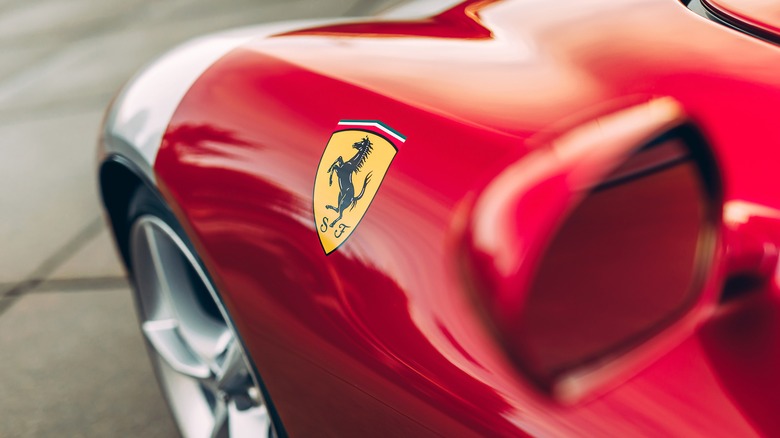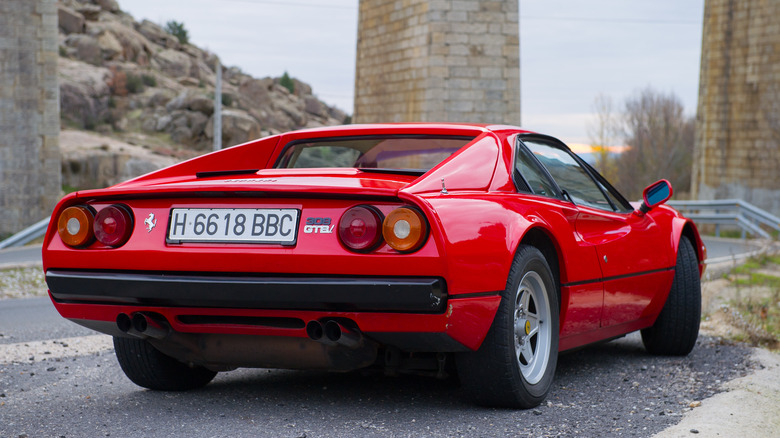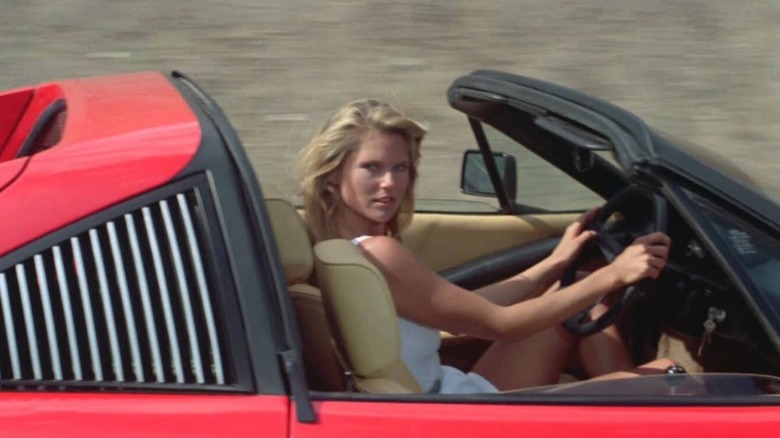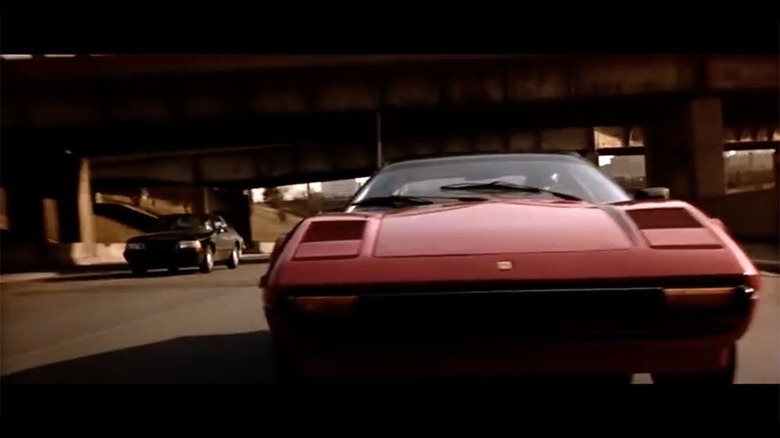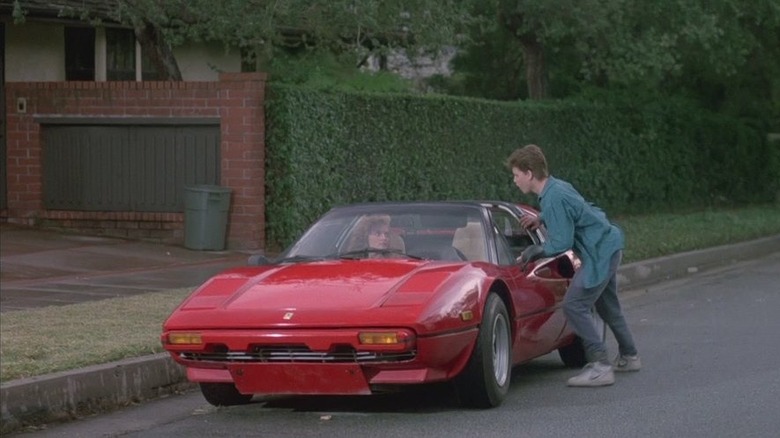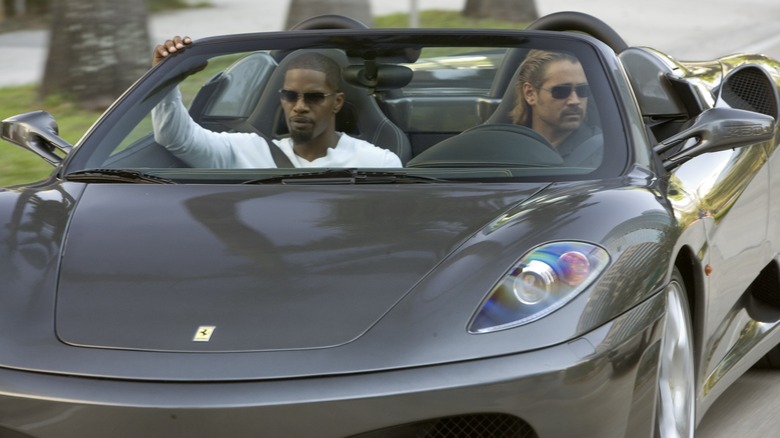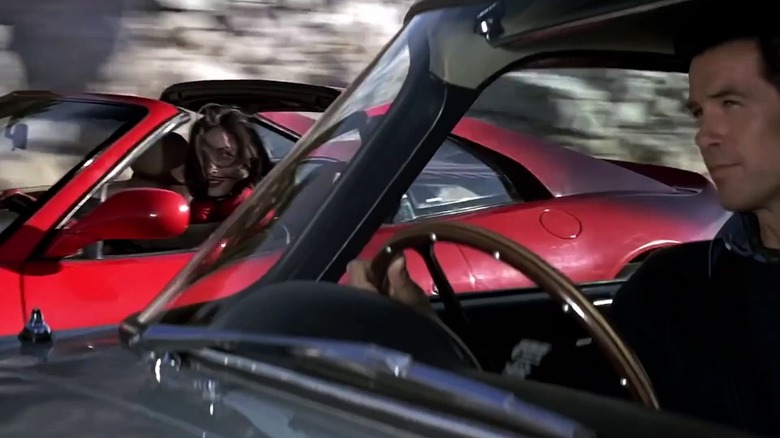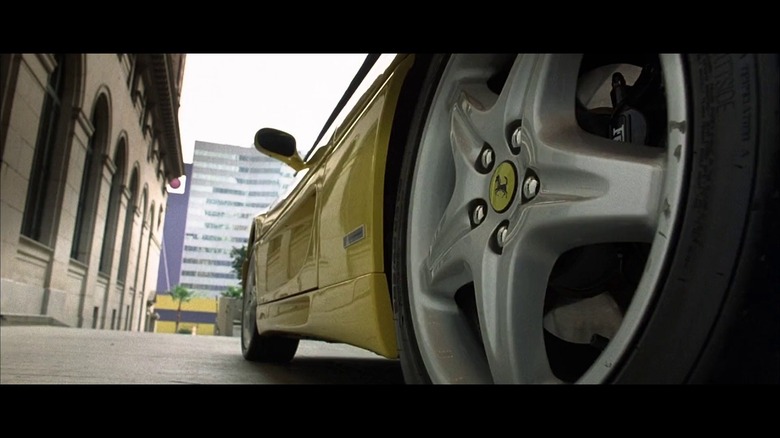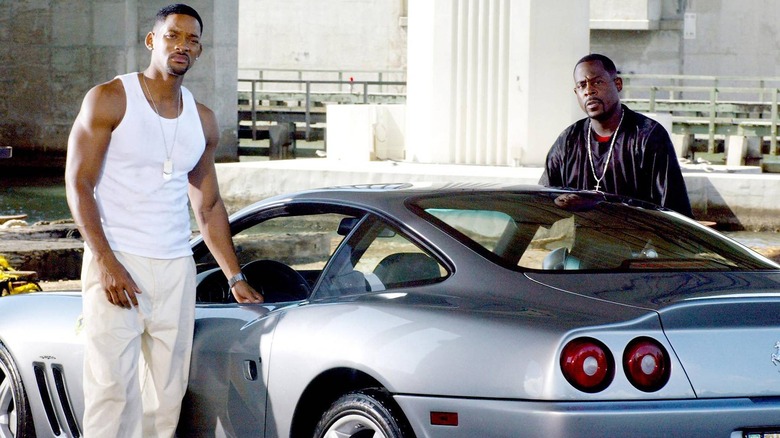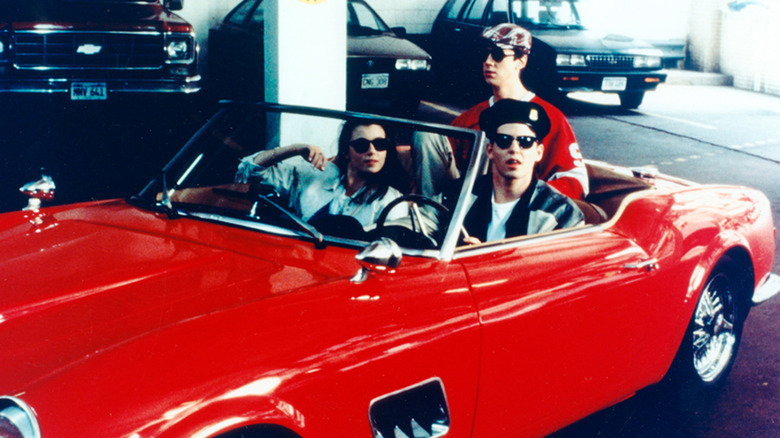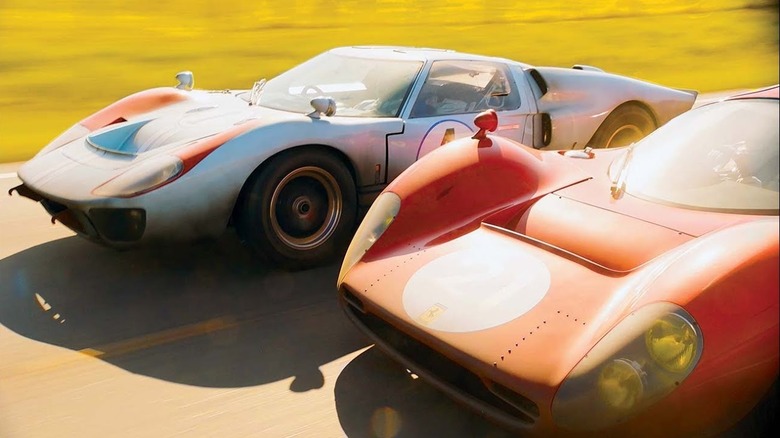The 10 Most Iconic Ferraris In Movie History
Ferrari is one of the most iconic car brands in the world. When you see the iconic sleek shapes of a sports car in cherry red, it's hard not to think of Ferrari. This is true both on the road and on the big screen. To date, only about 220,000 Ferraris have ever been built, and only approximately 8,400 Ferraris are built every year. Despite incredibly low production numbers, every gearhead has heard of a Ferrari, and those who know nothing about luxury cars still recognize the name Ferrari and the prancing horse logo.
Hollywood is always looking for symbols that convey speed, luxury, and glamor and frequently turns to Ferrari. These cars have graced the silver screen in numerous roles over the years — the grand prize in a high-stakes race, the car of choice for a thrilling chase, or the symbol of a character's success and status. ("Ferrari" is also the name of a new Adam Driver and Penélope Cruz movie, coming this Christmas to theatres, which follows its founder Enzo Ferrari at the company's lowest point.)
Their sleek design and unmatched performance make them a natural fit for cinematic moments that require a touch of adrenaline or elegance. When directors want to show a fast car or street race, Ferrari has been the go-to for movies to demonstrate power, speed, and maybe a bit of pretension. It helps that Ferraris are instantly recognized. Let's look at 10 of the most iconic Ferraris in movie history.
The Cannonball Run (1981)
The 1978 Ferrari 308 GTS, driven by Dean Martin and Sammy Davis Jr., is one of the most memorable Ferraris in movie history. This duo participated in the Cannonball Run, an unauthorized cross-country race that has captured the imagination of pop culture, inspiring films like "Death Race 2000," "Rat Race," and even the animated "Wacky Races" by Hanna-Barbera.
While most Cannonball Run participants opted for inconspicuous vehicles modified for speed, Martin and Davis Jr. chose the eye-catching 308 GTS. To divert attention, they masqueraded as priests. However, the sight of two "priests" in a Ferrari was far from discreet, leading to their memorable encounter with a rival team in an ambulance, portrayed by Burt Reynolds and Dom DeLuise. This gave rise to the unforgettable line: "When's the last time you saw two priests driving a Ferrari?"
The film culminates in a comically chaotic finish, but its blend of humor, iconic cars, and star-studded cast cements its place in both film and automotive lore. For a delightful mix of comedy and car chases, watching Sammy Davis and Dean Martin spar with Burt Reynolds and Dom DeLuise is a must.
National Lampoon's Vegas Vacation (1997)
National Lampoon's films are celebrated for their comedic brilliance. In the Griswald family's escapade to Las Vegas, the Ferrari 308 GTS hits the big screen in true Ferrari fashion.
In a recurring gag throughout the Lampoon series, a Ferrari-driving Christie Brinkley appears out of nowhere as eye candy for the station wagon-driving Clark Griswald. Time and again, Clark becomes comically enamored with both the car and its driver, often to his own embarrassment. As he sweats in his station wagon, he desperately tries to look cool when Brinkley pulls up alongside in her Ferrari.
The Ferrari randomly appears, speeding through the open roads, usually while the Griswald family isn't paying attention. This has often led to people speculating that Clark Griswald is imagining the entire event and that the Ferrari driven by the model is actually a figment of his imagination.
Nevertheless, this iconic scene has become a classic moment in National Lampoon's history and helped solidify Ferrari as a fantasy car in the daydreams of bored husbands.
Beverly Hills Cop II (1987)
In the sequel to the action-comedy "Beverly Hills Cop," Eddie Murphy redefined coolness in Beverly Hills. His character, Axel Foley, had the authority to procure any resources for his investigation, leading him naturally to choose the Ferrari 328 GTS.
Throughout the film, this Ferrari becomes a central prop as Axel Foley, alongside partners Billy Rosewood and John Taggart, delves deep to uncover who attacked their colleague, Captain Bogomil. The film's opening sequence remains a cinematic hallmark of the buddy cop genre. It showcases Eddie Murphy, wearing his badge and gun and navigating the city streets. The camera captures the Ferrari skillfully maneuvering narrow lanes and speeding on highways, culminating in Foley's dramatic arrival at work, with the Ferrari emblem prominently showcased during the opening credits.
Foley shines as the epitome of cool in the movie. The director knew that there couldn't be anything much cooler than a Ferrari-driving loose-cannon police officer. For those of you Ferrari fans with a keen eye, or a pause button, you may notice something interesting about the Ferrari in the opening scene. It's two completely different cars. In the opening scene, the camera swaps to a Ferrari 308 and a Ferrari 328 when the camera shifts. Throughout the rest of the film, it remains a 328.
License to Drive (1988)
In the quintessential '80s teen film "License to Drive," the two Coreys — Haim and Feldman — take center stage. This coming-of-age narrative revolves around the universal themes of freedom and defiance. The story follows Les (Corey Haim), who ruins his chances with his dream girl after spectacularly failing his driving test. Undeterred, he impulsively borrows his parents' classic Cadillac, leading to a series of comedic misadventures. But where does the Ferrari fit in?
"License to Drive" positions the Ferrari as the pinnacle of luxury, a dream out of reach for most. For Les, the Ferrari exists only in his wildest fantasies. Even his father's Cadillac, a symbol of luxury in its own right, is initially beyond his grasp. The film's opening scene epitomizes the teenage angst and boyhood fancy of the '80s. In this dream sequence, Les escapes from a menacing school bus driver by leaping into a striking red Ferrari 308. Beside him is his love interest, and together they navigate narrow alleys, dodging the relentless bus. The dream culminates in a dramatic escape, with Les igniting a trail of gasoline, leaving a fiery spectacle in his wake.
While this scene is a mere figment of Les's imagination, it underscores a timeless allure. The fantasy of driving a Ferrari has captivated audiences since the '80s, and its portrayal in media remains as powerful as ever.
Miami Vice (2006)
Sticking with the '80s theme, it's impossible to talk about Ferraris on-screen without mentioning "Miami Vice." Detectives Sonny Crockett (Don Johnson) and Ricardo Tubbs (Philip Michael Thomas) were the pinnacles of cool in their pastel suits accompanied by synth soundtracks and action adventure.
What's remarkable is that their initial "Ferrari" was not genuine. The show featured a replica Ferrari Daytona Spyder constructed on a Corvette chassis. Understandably, Ferrari took issue with the fact that one of TV's most iconic Ferraris was, in fact, an imitation. This led to the dramatic on-screen destruction of the replica in the opening episode of the third season. In a gesture of authenticity, Ferrari subsequently provided the show with two genuine Ferrari Testarossas, ensuring that Crockett and Tubbs continued their adventures in Miami, this time in the genuine article.
Later in 2006, "Miami Vice" would get a makeover for the big screen. Instead of the cocaine white of the TV show, Tubbs and Crockett would be driving a Grigio Silverstone Ferrari F430 Spider. It's introduced while absolutely flying down the Miami freeway with blue flames shooting out of the exhaust pipe as the two detectives chase down an informant. It's a gorgeous car and a nod to the classic TV series that came before. The F430 Spider was chosen over the series' classic model to help pull the cult show into a modern adaptation on the big screen.
GoldenEye (1995)
"GoldenEye" was peak Pierce Brosnan James Bond. It was the perfect blend of action and quirkiness that made the series thrilling and fun to watch. The '90s were a simpler time when movies didn't all have to be Christopher Nolan-levels of dark and angsty. Before Daniel Craig rebooted James Bond into the unstoppable action hero, he was portrayed as a martini-loving spy with a wry smile.
The scene that epitomizes Brosnan's portrayal of Bond was the showdown between his Aston Martin DB5 vs. a Ferrari F355. Here, Bond street races with the villain, Xenia Onatopp, notorious for her lethal seduction. It's the kind of audacious plotline that's quintessentially Bond. The two cars battled it out on a winding mountain road, the Route de Gentelly in France.
While the Ferrari F355 showcases its command of the road, making every twist and turn a visual treat, Bond's Aston Martin inevitably steals the spotlight. The F355 faces not one but two off-road detours, courtesy of Bond's maneuvers — one to overtake and the other to dodge the cliché tractor pulling a load of hay. Despite its setbacks, the Ferrari showcases an impressive recovery from a dramatic skid, weaving between cyclists and a cliff edge, a nod to the classic car chase tropes.
The scene ends with Bond pulling the hand brake and revealing a bottle of champagne for his lady friend in the passenger seat. This iconic duel between the DB5 and F355 only boosted both cars' popularity at the time.
The Rock (1996)
"The Rock" put Nicholas Cage and Sean Connery together to make one of the best thrillers of the '90s and included one of the most memorable car chases in movie history. While Ferraris in films are typically contrasted against other supercars or dilapidated vehicles to highlight the disparity, director Michael Bay chose a unique matchup: a Ferrari F355 Spyder versus the sheer might of a Humvee.
Special agent Stanley Goodspeed (Cage) commandeers the vehicle and goes after escaped convict John Mason (Connery). The chase leads them through the winding streets of San Francisco. The Humvee smashes through everything in its path knocking cars and debris out of its way as it plows through the streets. Meanwhile, Goodspeed displays the speed and agility of the Ferrari by swerving and navigating the narrow streets and avoiding every obstacle in its path. It's the classic matchup of raw power vs. speed and agility.
Although just a short scene in the movie, Michael Bay created one of the most iconic Ferrari car chases on screen that still holds up to this day.
Bad Boys II (2003)
Michael Bay must really like Ferraris because he's attributed to yet another iconic Ferrari on the main screen. This time it's from the buddy action flick "Bad Boys II."
"Bad Boys II" not only showcases one of cinema's most action-packed Ferrari sequences on screen but also cements the dynamic duo of Will Smith and Martin Lawrence as the epitome of buddy-cop partnerships.
Transporting these protagonists is the stunning Ferrari 550 Maranello. Eschewing the brand's signature red, Bay chose a distinctive blue for this vehicle. The film is replete with high-octane scenes, gunfights, and explosions — hallmarks of both a quintessential action movie and a Michael Bay production.
Yet, amidst this whirlwind of action throughout the movie, the Ferrari chase sequence stands out as one of its best scenes. Smith and Lawrence's characters end up in a pulse-pounding high-speed pursuit on Miami's MacArthur Causeway. The 550 Maranello, with its unparalleled agility and speed, effortlessly navigates through traffic, evading both bullets and vehicles. This scene underscores the Ferrari's attributes: swift, audacious, and undoubtedly chic, mirroring the film's lead characters in "Bad Boys II."
Ferris Bueller's Day Off (1986)
No mention of Ferraris on film would be complete without John Hughes's classic coming-of-age story, "Ferris Bueller's Day Off." In fact, Ferris Bueller said it best, "If you had access to a car like this, would you take it back right away? Neither would I."
The story revolves around the fun-loving and charismatic Ferris Bueller, his girlfriend Sloane, his close friend Cameron, and notably Cameron's father's prized Ferrari 250 GT. This cherished car goes on its own adventure in the film, taking the trio downtown, only to be stolen by parking attendants.
The finale of the Ferrari ultimately sees it crash through a glass window and smashed at the bottom of a ravine. Luckily, a replica was used during filming, but it's still gut-wrenching to see. The Ferrari acts as a symbol of rebellion, youth, and coming of age. It symbolizes the key to freedom for Ferris and the gang as they explore and take advantage of everything life has to offer. Eventually, the party has to end, though, and one of the defining moments of the movie is Cameron confronting his father about the destroyed car.
"Ferris Bueller's Day Off" is a classic film with an incredible Ferrari at its core. As with most John Hughes movies, It's more than just a car — it's a metaphor for youth.
Ford v Ferrari (2019)
Ferrari's reputation as a powerhouse in the automotive industry once again put it as the Goliath needed to be slain by David. "Ford v Ferrari" looks at the world of professional racing, particularly the 24 Hours of Le Mans race in France during the 1960s. It was an incredible time when what could be achieved in the automotive industry was only just being discovered. Ferrari dominated the circuits and was at the peak of performance, engineering, and mechanical standards.
This was challenged by the Ford motor company, and in particular, one automotive designer, Carroll Shelby. The film is filled with incredible track races that pit the Ford GT40 against the Ferrari 330. Both of these cars have made automotive history for their performance and design.
During this period, Ferrari reigned supreme. It won every single contest, and it truly seemed like nobody could beat the Italian maestros. It wasn't until 1966 that Ferrari was eventually unseated. "Ford v Ferrari" is an amazing movie detailing how Shelby eventually overtook Ferarri in the Le Mans endurance race.
Matt Damon as Carroll Shelby and Christian Bale as driver Ken Miles put on an impressive performance. Although Ferrari fans may be disappointed to see the prancing horses not come out on top, it brings one of the most dramatic events in automotive history to life on the big screen.
